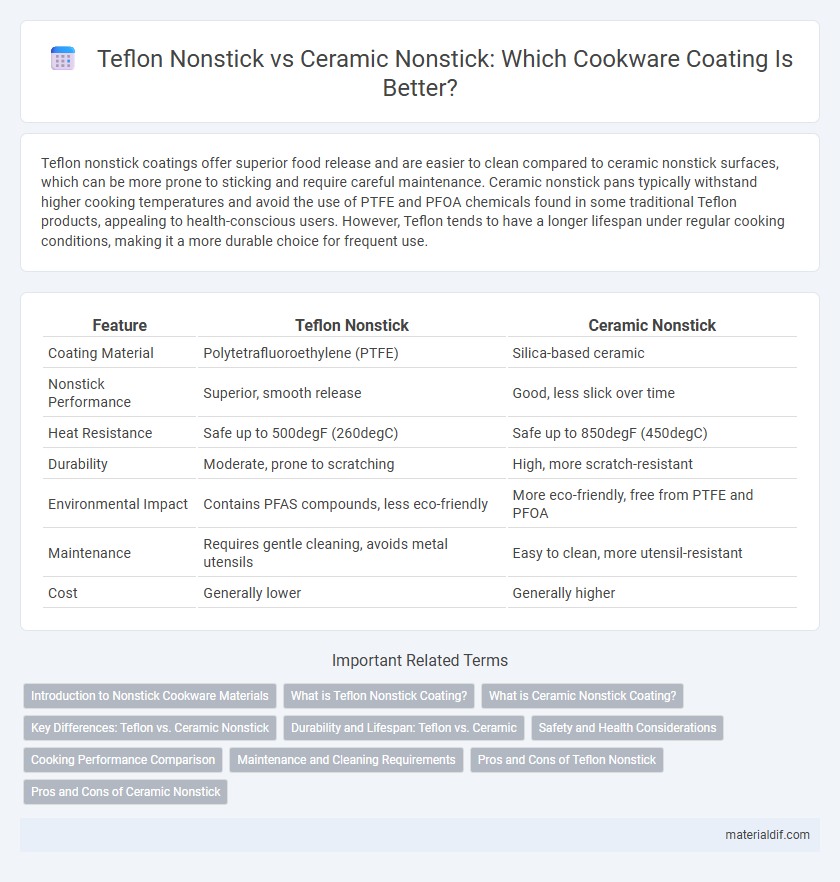Teflon nonstick coatings offer superior food release and are easier to clean compared to ceramic nonstick surfaces, which can be more prone to sticking and require careful maintenance. Ceramic nonstick pans typically withstand higher cooking temperatures and avoid the use of PTFE and PFOA chemicals found in some traditional Teflon products, appealing to health-conscious users. However, Teflon tends to have a longer lifespan under regular cooking conditions, making it a more durable choice for frequent use.
Table of Comparison
| Feature | Teflon Nonstick | Ceramic Nonstick |
|---|---|---|
| Coating Material | Polytetrafluoroethylene (PTFE) | Silica-based ceramic |
| Nonstick Performance | Superior, smooth release | Good, less slick over time |
| Heat Resistance | Safe up to 500degF (260degC) | Safe up to 850degF (450degC) |
| Durability | Moderate, prone to scratching | High, more scratch-resistant |
| Environmental Impact | Contains PFAS compounds, less eco-friendly | More eco-friendly, free from PTFE and PFOA |
| Maintenance | Requires gentle cleaning, avoids metal utensils | Easy to clean, more utensil-resistant |
| Cost | Generally lower | Generally higher |
Introduction to Nonstick Cookware Materials
Teflon nonstick cookware features a polytetrafluoroethylene (PTFE) coating known for its exceptional slipperiness and resistance to high heat, making it ideal for low to medium temperature cooking. Ceramic nonstick cookware uses a silica-based coating derived from sand, offering a naturally nonreactive and environmentally friendly alternative that withstands higher temperatures without releasing harmful fumes. Both materials provide easy food release and cleaning benefits, but their distinct chemical compositions influence durability, heat tolerance, and safety considerations in everyday kitchen use.
What is Teflon Nonstick Coating?
Teflon nonstick coating, made from polytetrafluoroethylene (PTFE), provides a slick surface that prevents food from sticking during cooking. It offers excellent heat resistance up to approximately 500degF, making it durable for everyday use in frying pans and bakeware. Unlike ceramic coatings, Teflon is known for its superior nonstick performance and easy food release properties.
What is Ceramic Nonstick Coating?
Ceramic nonstick coating is a water-based, environmentally friendly alternative made from silica derived from sand, offering a naturally nonstick surface without the use of harmful chemicals like PTFE and PFOA found in Teflon. This coating provides excellent heat resistance and durability while maintaining a smooth, easy-to-clean surface ideal for healthy cooking with minimal oil. Ceramic nonstick pans are favored for their non-toxic composition and ability to withstand high temperatures without emitting fumes.
Key Differences: Teflon vs. Ceramic Nonstick
Teflon nonstick coatings, made from polytetrafluoroethylene (PTFE), offer superior nonstick performance and ease of cleaning compared to ceramic coatings, which are made from inorganic minerals. Ceramic nonstick pans provide higher heat resistance and are often marketed as a safer, eco-friendly alternative due to their chemical-free composition, but they tend to wear out faster and lose nonstick properties over time. Key differences include durability, heat tolerance, and the presence of synthetic chemicals, with Teflon excelling in longevity and slickness while ceramic prioritizes environmental safety and higher safe cooking temperatures.
Durability and Lifespan: Teflon vs. Ceramic
Teflon nonstick coatings are known for their superior durability and longer lifespan compared to ceramic nonstick surfaces, often lasting up to five years with proper care. Ceramic coatings, while eco-friendly and free from PTFE and PFOA, tend to wear out faster, typically showing signs of deterioration within one to two years due to their brittle nature. The resilience of Teflon's polymer structure allows it to withstand higher cooking temperatures and frequent use without significant degradation.
Safety and Health Considerations
Teflon nonstick cookware contains polytetrafluoroethylene (PTFE), which can release toxic fumes when overheated above 500degF, posing risks such as polymer fume fever in humans and toxicity to pet birds. Ceramic nonstick coatings are made from inorganic minerals and free from PTFE and perfluorooctanoic acid (PFOA), offering a safer alternative with lower risk of harmful chemical exposure. However, ceramic coatings may degrade faster and require careful use to maintain their nonstick and safety properties.
Cooking Performance Comparison
Teflon nonstick cookware offers superior food release and requires less oil, enhancing healthier cooking and easy cleanup compared to ceramic nonstick surfaces. Ceramic nonstick excels in high-heat resistance but may exhibit faster wear, impacting long-term durability and consistent cooking performance. Teflon's proven PTFE coating maintains nonstick efficiency over extensive use, making it preferable for precision cooking and frequent kitchen tasks.
Maintenance and Cleaning Requirements
Teflon nonstick cookware requires gentle cleaning with non-abrasive sponges to preserve its coating and should be washed by hand to avoid damage. Ceramic nonstick surfaces are more resistant to high temperatures and can often withstand dishwasher cleaning, but still benefit from delicate washing to maintain their nonstick properties. Both types demand avoidance of metal utensils to prevent scratching, ensuring longevity and optimal performance.
Pros and Cons of Teflon Nonstick
Teflon nonstick cookware offers superior release properties, making food cooking and cleanup effortless. Its high heat resistance up to 500degF ensures durability but degrades at temperatures above 600degF, potentially releasing harmful fumes. However, Teflon coatings may scratch easily, compromising nonstick performance and requiring careful use to avoid health risks associated with damaged surfaces.
Pros and Cons of Ceramic Nonstick
Ceramic nonstick cookware offers a chemical-free, environmentally friendly alternative to traditional Teflon nonstick surfaces, providing excellent heat retention and even cooking. However, ceramic coatings can be less durable, prone to chipping, and may lose nonstick effectiveness faster under high temperatures. The natural composition makes ceramic nonstick ideal for low to medium heat cooking but less suitable for prolonged high-heat applications.
Teflon Nonstick vs Ceramic Nonstick Infographic

 materialdif.com
materialdif.com